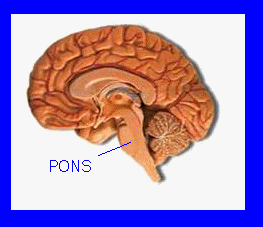 The BRAIN!
The BRAIN!
Medulla
LOCATION: most
inferior part of the brain stem
FUNCTION:
· Regulates:
· Heartbeat
· Respiration
· Blood pressure
· Reflex center for:
· Swallowing
· Coughing
· Sneezing
· Vomiting
· Relays messages to other parts of the brain
EXTRA PARTS:
· A number of cranial nerves (part of the PNS) originate on the
medulla. These include: IX. glossopharyngeal, X. vagus, XI.
spinal accessory, XII. hypoglossal and VIII. the
vestibulocochlear which attaches to both the medulla and pons.
· The pyramidal tracts also cross on the medulla

Pons (a.k.a. pons varolii)
LOCATION: superior
to (above) the medulla
FUNCTION:
· Acts as a "bridge" linking portions of the brain
· Helps regulate
· Respiration
· Chewing
· Facial expression
· Eye movements
EXTRA PARTS:
· Cranial nerves that originate in pons include V. trigeminal,
VI. abducens, VII. Facial, VIII. vestibulocochlear (with
medulla).

Midbrain (a.k.a. mesencephalon)
LOCATION: superior
to (above) pons
FUNCTION:
· Superior colliculi are responsible for visual reflexes
· Inferior colliculi are responsible for auditory reflexes
· Eye movements
· Red nucleus controls muscle tone and posture
EXTRA PARTS:
· Cerebral peduncles
· Corporal quadrigemina
· Roof of midbrain is called the tectum
· Contains the corpora quadregemina
· Divide into the superior and inferior colliculi
· Cranial nerves originating at midbrain include III. oculomotor
and IV. trochlear.

Diencephalon (has TWO parts)
THALAMUS
FUNCTION:
· Main relay center for conducting information by sorting
information and sending it to proper region of cerebrum
· Receives ALL sensory information except smell
· Responsible for crude touch, pressure, temperature
· Also responsible for basic emotions such as rage and fear
HYPOTHALAMUS
LOCATION: inferior
to the thalamus
FUNCTION:
· Control center for:
· Body temperature
· Appetite
· Thirst
· Regulates the pituitary gland
· Links the nervous and endocrine systems
· Helps control Autonomic Nervous System
· Responsible for some emotional and sexual responses
· Manufactures antidiuretic hormone (ADH)
EXTRA PARTS:
· Optic chiasma (where optic nerves cross)
· Mamillary bodies (feeding reflexes like swallowing and licking
the lips)
· Infundibulum (connects hypothalamus to pituitary gland)

Cerebellum
FUNCTION:
· Responsible for smooth, coordinated movement and maintaining
posture and muscle tone
· Helps maintain equilibrium (balance)
PARTS:
· Arbor vitae

Cerebrum
FUNCTION:
· Center of:
· Intellect
· Memory
· Language
· Consciousness
· Receiving/interpreting all sensory information
· Controls motor functions
PARTS:
· Six lobes
· Frontal
· Parietal
· Occipital
· Temporal
· Limbic
· Central
· Corpus callosum (largest commissure between the two
hemispheres of the brain)
· Fornix (another commissure)

Limbic System
FUNCTION:
· Plays a role in:
· Emotional responses
· Autonomic responses
· Subconscious motor and sensory drives
· Sexual behavior
· Biological rhythms
· Feelings of pleasure and punishment
PARTS:
· Limbic lobe (of cerebrum)
· Hippocampus
· Amygdala
· Olfactory nerves, bulb and tract
· Fornix
--------------
click here to go back to home page